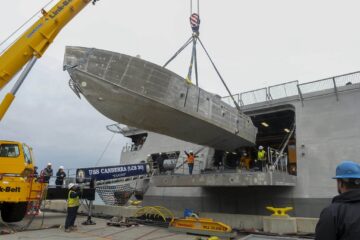At MAST Asia 2019, the defense exhibition and conference currently held near Tokyo, Japan, French company iXblue unveiled its SEADRiX USV for persistent anti-submarine warfare missions.
SEADRiX consists in the pairing of iXblue’s sea proven DRiX USV with British company SEA’s KraitArray user-configurable thin line array. The combination of both system creates an “unmanned sound barrier” system (both passive & active), similar to the famous SOSUS network, with the notable difference that the sensors are now mobile.
Naval News sat down with iXblue’s Guillaume Eudeline, Global Business Development, Ships & Drones, to find out more about this new system.

Naval News – Why and when did iXblue partner with SEA ?
Guillaume Eudeline – A few years ago, the UK MoD, through its Defence Science and Technology Laboratory (Dstl), put together the Progeny Maritime Research Framework contract. Its goal is to deliver innovative and cost effective solutions that can be exploited by the UK Armed Services.
Progeny is divided in a number of task, one of which (task 13) is dedicated to developing autonomous ASW.
SEA contacted us last summer. They were bidding for PROGENY task 13, and were looking for an autonomous platform capable of towing the Krait Array. iXblue USV, DriX, caught their attention and they reached out. At iXblue, we saw the potential of it. And jumped onboard at that time, under SEA banner.
Naval News – Have you tested the USV fitted with the KraitArray ?
Guillaume Eudeline – We’ve just completed phase 1, which was a “dry” phase. The goal was to present a relevant proof of concept on paper. A number of things were developed, and models ran. It was a success and SEA was selected to go to phase 2, when the “wet” part will be.
First sea trials will start by the end of the current year.
Naval News – What is the (expected) performance impact of the KraitArray on the DriX ?
Guillaume Eudeline – Towing an array (or anything) creates drag and produces an impact on DriX usual performances. This impact is, however, negligible given the task at hand.
And that for several reasons.
In order to be efficient, a passive sensor array needs to be as far as possible from the towing ship’s radiated noise. This is achieved by adding a certain length of rope between the array and the towing ship. It adds a drag in proportion. Here, we have a very silent DriX, and the length of “neutral rope” is quite short. The resulting drag is therefore limited.
Then, the SEA Krait Array itself is impressively light and its volume is very reduced (no more than a garden hose). The towed weight is therefore reduced, and so is the resulting drag.
Naval News – What missions is the system designed to fulfill ?
Guillaume Eudeline – As of now, the mission is to create a moving passive barrier by putting a number of passive acoustic sensors in the water, and the warfare domain is ASW.
Naval News – What are its key strengths (compared to other solutions such as using a VDS from a surface ships or a dipping sonar from a helicopter) ?
Guillaume Eudeline – It is difficult to compare things of very different nature. Suffice to say that this system:
- Provides persistence over a large area,
- Allows detection in passive mode from multiple angles
- Is cost effective and covers the needs of our interlocutors without adding things they don’t ask for.

Naval News – For which concept of operation / how is it supposed to be used? (on its own for long endurance passive surveillance? or in conjunction with other, bigger vessels, for multi static ASW)?
Guillaume Eudeline – The concept of operations is not ours to decide, but would be the Royal Navy. And at any rates, the system provides only a part of the ASW solution. DriX is not fitted with weapons, and the engagement is still in the hands of traditional assets.
There are however a number of ideas, chief amongst which:
- The use of a pack of DriXes, launched from a low-tech mother vessel (from a military stand point) such as a supply vessel. They are launched, form a line with a spacing between each dictated by the mission and local propagation conditions, and they cover a wide area for a long time (many days, including replenishment if needed).
- The use of DriX+Krait Array individually, amongst a larger force. Launched from an escort vessel, it allows one to put extra sensors in the water, to clear a choke point or protect a given area (a CVOA for instance).
Multi static is quite complicated to achieve, but since it relies on multi platforms, yes, it could be an option in the future.
Naval News – Have you started marketing/demonstrating the system to customers ? What is their initial reaction ?
Guillaume Eudeline – The interest is huge. It is both cost efficient, affordable, and adapted to the needs of navies around the world. Also, it does not require a lot of manpower to use.
Naval News – What is next for this project ?
Guillaume Eudeline – Succeeding in phase 2 and have it operational in the RN and other navies ASAP, either through big defence contractors or directly through procurement agencies.
A number of countries (which I am not willing to name) have already shown a lot of interest in that solution. Hopefully, it will be a success.
The Demonstration will prove:
- Safe and effective autonomous operation
- The ability to conduct “sprint and drift” acoustic searches in open ocean
- Operation in high sea states and GPS denied environments
- System endurance, robustness and flexibility
- Search, detect and track tactics
- Operator interventions, off board processing and retasking
We are confident the system will provide the performance, persistence and practicality to become a significant asset in the ASW war fighters armoury.






